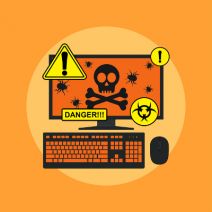Computerware Blog
Ransomware remains a very real threat, and is arguably only getting worse. Attacks are now able to come more frequently, and there are opportunities for even relative amateurs to level an attack against some unfortunate victim. However, this is not to say that there is nothing you can do to keep your business from becoming another cautionary tale.
Doing business on the Internet is a dangerous gambit, and not one which should be taken lightly. Every small business uses some kind of sensitive information that is valuable to hackers. Most think that preventative measures are enough to ensure their security, but the fact remains that only through threat detection and elimination can you guarantee that all issues are promptly handled.
The threats to your organization’s infrastructure are numerous and plentiful, and while some will make themselves known immediately, others will hide in plain sight. These threats are designed to either leak information or provide new outlets for hacking attacks. Regardless, it’s important to identify attacks that have weaseled their way through your defenses before they have been around long enough to cause damage.
Breaches are Inevitable
To truly understand how threat detection is just as important as threat prevention, you need to come to grips with the worst-case scenario. It’s not an uncertainty that you’ll be hacked at some point--in fact, it’s very likely, and as such, you need to make sure that you’re prepared for any and all situations, including a data breach. Even large organizations and enterprises that pride themselves on security can experience data breaches. Consider the high-profile hacks of Sony and the United States Office of Personnel, as well as the health care provider Excellus BlueCross BlueShield. If these organizations had anticipated data breaches, perhaps they may have been able to prevent them--or at least mitigate the damage.
This is why you absolutely need to expect the worst in order to keep it from happening. While preventative solutions can help, it’s also imperative that you implement ways to detect intrusions, as well as ways to eliminate threats. Only then can you be ready to tackle any and all threats that want to hurt your business.
What You Can Do
CIO recommends what they call a preventative “triad” of sorts. This includes protection, detection, and reaction. You’ll need both security solutions like a firewall, and monitoring tools that allow you to check (and eject) threats from your network.
Computerware can get your business started with solutions designed to mitigate threats and prevent infections in the first place. A Unified Threat Management (UTM) solution provides a firewall, antivirus, spam blocker, and content filter, which is a great way to keep threats from accessing your network. Furthermore, we also offer a Remote Monitoring and maintenance (RMM) tool that can help our technicians keep an eye on your network for any discrepancies or inefficiencies.
To learn more, reach out to us at (703) 821-8200.
Ransomware is a dangerous online entity that continues to cause problems for businesses of all sizes. Thanks to its ability to encrypt workstations and even entire networks, ransomware has made its way to the top of the threat food chain, and it’s your responsibility to protect your business from it. Since infections are (more or less) impossible to remove, your best option is to prevent infections from happening in the first place.
Here are five of the best practices you need to keep in mind to protect your business from ransomware.
Have a Data Backup and Disaster Recovery Solution
If your business is struck with ransomware, the only reliable way to resolve the problem is to restore a data backup. The reasoning is simple; while you could pay for the decryption key, you would only be further funding their ransomware campaigns, and there’s no guarantee that the decryption key will work in the first place. You’re better off not taking the risk and just restoring a backup… assuming you have one.
Set a Routine for Scheduled Backups
You’ll want your backup and disaster recovery solution to be able to restore your data as close as possible to the point of incident. Computerware has a BDR solution available that can create backups of your data as often as every fifteen minutes. This is crucial if you want to ensure that your data recovery process is sound.
Educate Your Employees About Phishing Scams
Keeping your team in-the-know of how to avoid phishing scams and identify threats is a good step to take for any and all security risks. Teach them not to download unsolicited attachments or click on suspicious links. It also helps to remind them to look for signs of phony email domains, spelling errors, and other irregularities.
Regularly Update Your Software Solutions
The latest patches and security updates can go a long way toward keeping your organization from experiencing hacking attacks. As such, ransomware works the same way. Keep comprehensive security solutions on-hand that can keep phishing attacks from hitting your email inbox in the first place.
Keep Corporate Data Separate From Personal Data
If you have corporate data that’s stored on your in-house workstations, you’ll want to keep it separate from data that’s stored on employee mobile devices. If you use laptops or smartphones to work remotely, this can be challenging. You should stress that employees keep these two types of information as separate as possible. One way to do this is by storing corporate data in a cloud environment, so that employees don’t have to store it on their mobile devices at all.
The best way to guarantee your business’s assets aren’t being put at risk is to keep ransomware from happening in the first place. Take the time to reinforce your infrastructure and educate your team, and you might be surprised by the results. To learn more about how to do this, reach out to us at (703) 821-8200.
There are countless threats out there that can mean danger for your business, but one of the most innovative to date utilizes a malicious Twitter account to administer commands to a botnet made up of infected Android devices. In fact, this is widely considered the first threat to actively use a social network in this manner, making it a wake-up call for security professionals and social media users alike.
Ransomware might be a relatively new player in the battle for the Internet, but its short history shouldn’t belittle the damage that it can do to both businesses and users of personal computers. Perhaps you’ve had the misfortune to encounter it for yourself, and your files were locked down because of it. Regardless, ransomware is now a prevalent part of the online crime scene, and people are using it to extort money from innocent users, making it a considerable threat.
First hackers created a formidable ransomware. Then, when word got out about how to avoid this ransomware, they began to bundle a second ransomware to create an encryption catch-22. Now, the developers of the Petya and Mischa ransomware have adopted a Ransomware-as-a-Service model and have opened their nefarious malware up to distribution.



















